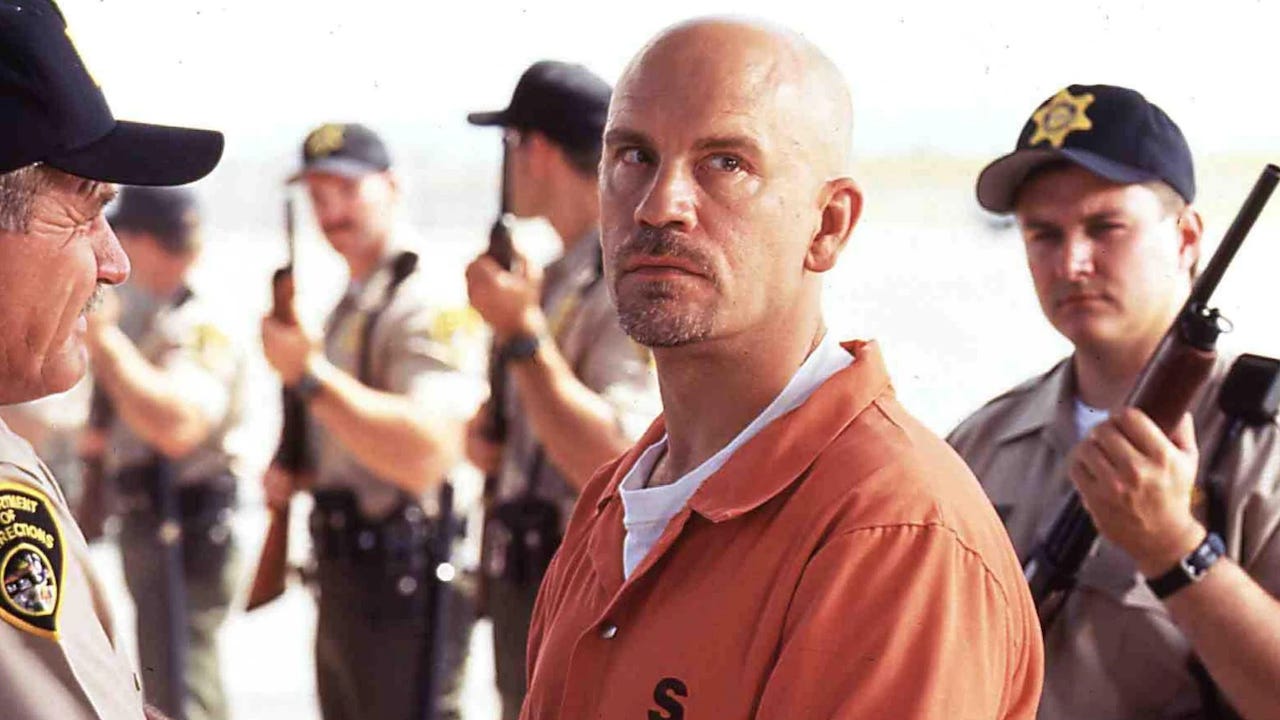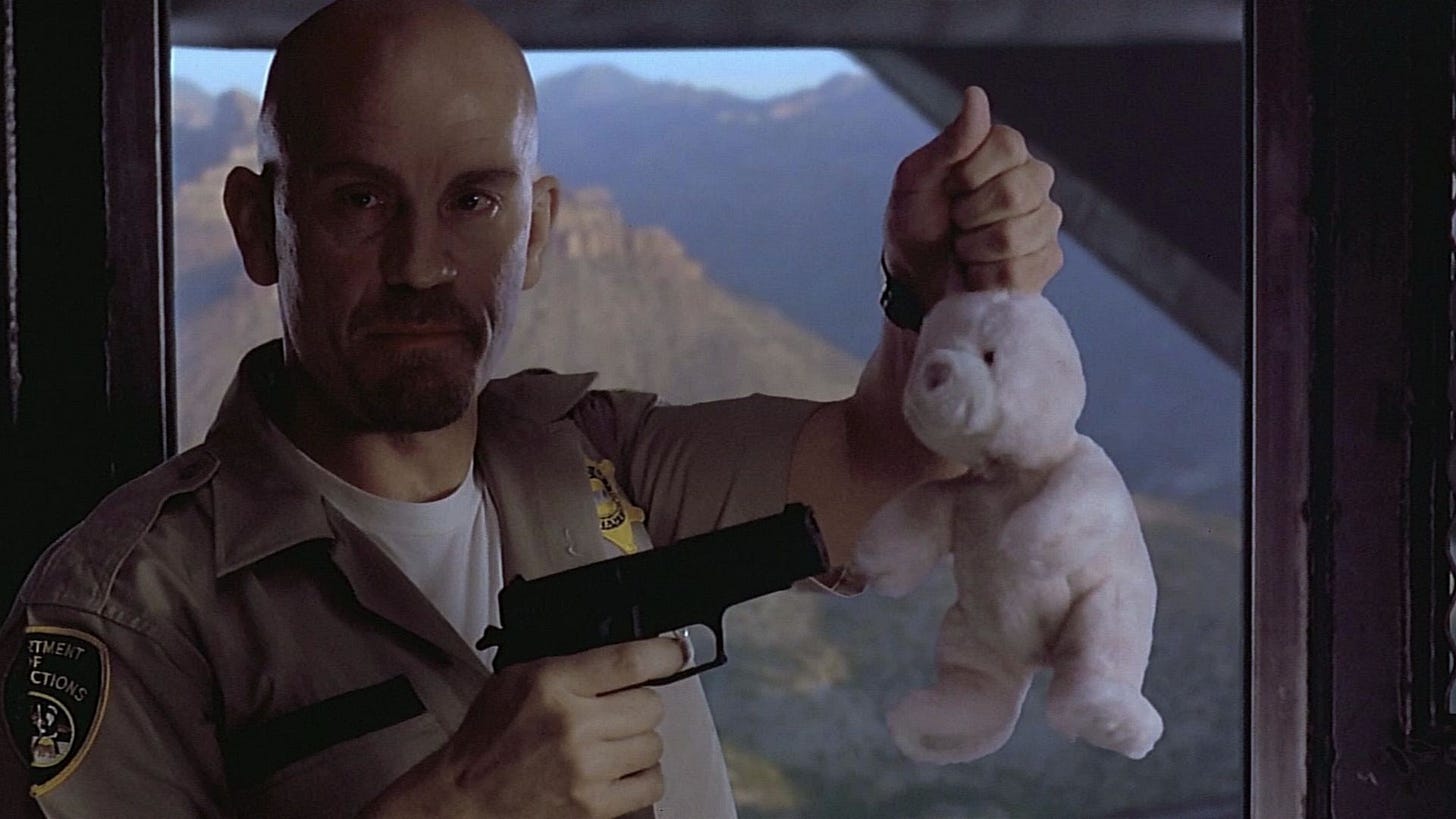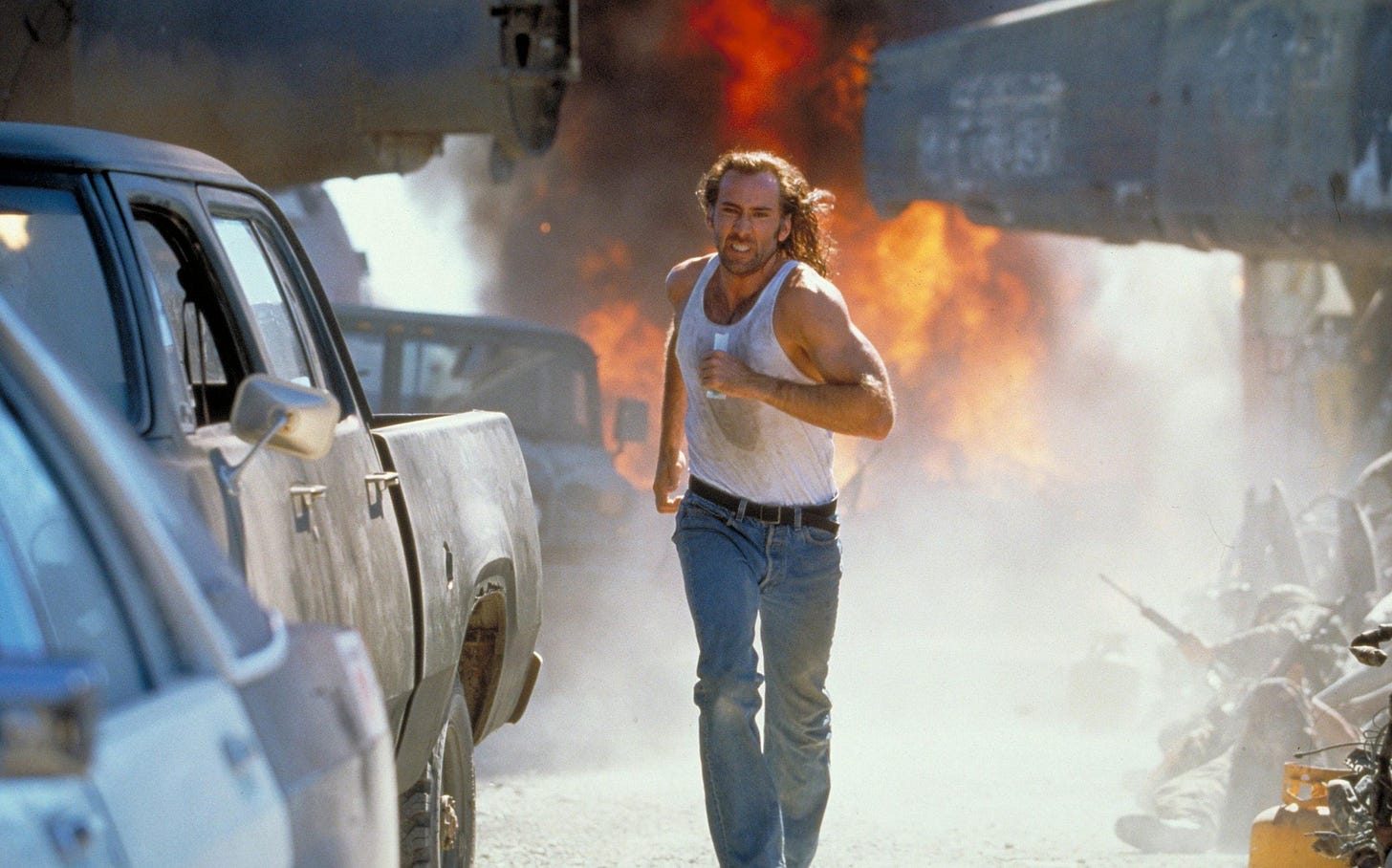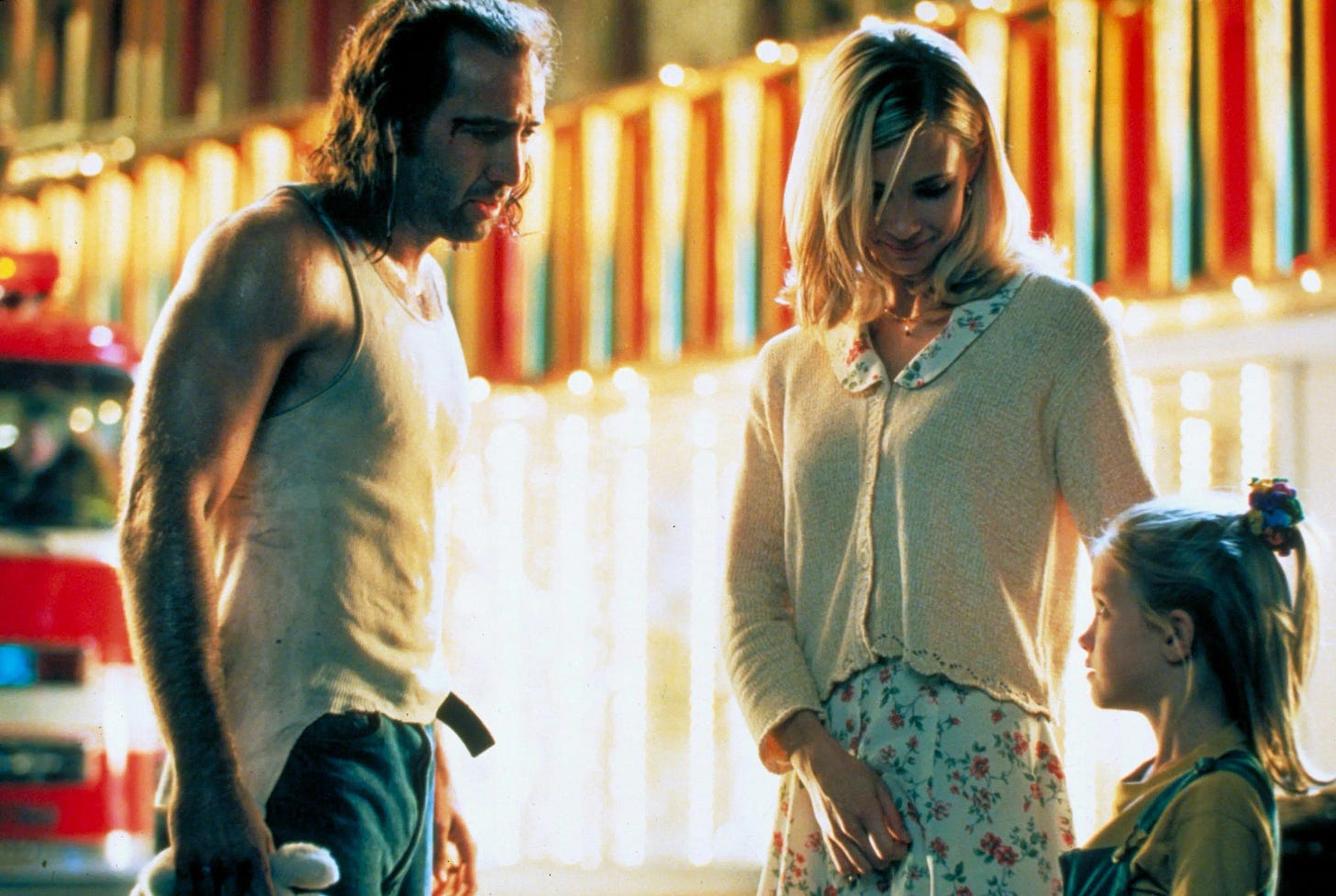Pizza & a Movie #62: "Con Air"
What happens if you put all the tough guys in Hollywood on one plane?
“Con Air”
1997 • R • 1h 55mins • Watch trailer • Buy Digital • Buy disc
👋🪨 The Hand that Rocks the Cagel: Three Nic Cage action movies in a row
You’re reading Pizza & a Movie—rewinding the stories of rental classics. This week we’re smack in the middle of a Triple Header: The Hand that Rocks the Cagel. With our Cage already rattled, we’re unleashing the action-packed triad that defined Cage’s turn from dramatic actor to guy with a gun and a job to do. Tonight we gotta get there, and quick. And the only way is to fly. Check your baggage for Con Air.
Here’s the plot. Army Ranger Cameron Poe (Nicolas Cage) just got to Mobile, Alabama from Desert Storm. He’s out, he’s done. Now it’s a night on the town to celebrate with his wife, Tricia (Monica Potter), who has a bun in the oven. Drunk locals menace Tricia, which is when Poe beats the ever-loving tar out of them. Turns out the Army taught him how to open up a can of whoopin’ but not how to close it, because one guy’s dead. It gets Poe a decade behind bars. He’ll miss the birth and childhood of his daughter, Casey (Landry Allbright).
Eight years, many workouts and a lot of correspondence later, Poe’s out of the slammer early. A one-way ride on prison transport plane the Jailbird is the only thing between him and his family. Oh, and every other con aboard. You’ve got your high-functioning psychopath, Cyrus the Virus (John Malkovich). Your low-functioning psychopath, Billy Bedlam (Nick Chinlund). Your right hand man, Diamond Dog (Ving Rhames). Your left-hand man, Swamp Thing (M.C. Gainey). Your Chatty Kathy, Pinball (Dave Chappelle). Your the-one-from-Forrest Gump, Baby-O (Mykelti Williamson). Your that-number-seems-low, Johnny 23 (Danny Trejo). Your this-seems-insensitive-even-for-Con Air, Ramon (Renoly Santiago). These fellas have let’s call it an “alternative flight plan”.
Meanwhile, on the ground, Birkies-with-socks-wearing US Marshal Vince Larkin (John Cusack) and his vintage ‘Vette-owning colleague Duncan (Colm Meaney) try to figure out what’s gone awry in the sky before things take a turn for the permanent. Can Poe outwit the baddies to regain his freedom? Will Larkin unravel the plot in time to help? And, wait a minute, where are all the hairdryers the title promises?
Just like Carla in The Rock, Monica Potter’s Tricia is more of an abstract idea than a person. She’s there to draw out a man’s most honorable self and set up false dichotomies oops uh I mean “tough choices”. Thankfully it’s not the level of misogeny a decade earlier had to offer in hits like Die Hard. But Con Air is a man’s world, written and shot by men.
How’d we get Con Air? You’re not gonna believe this, but it’s kinda based on real life. It all started with the ’93 LA Times article When Jailbirds Fly, They Always Use “Con Air”. Here’s the true stuff:
It’s operated by the US Marshals
Flights avoid major civilian airports
The planes are huge—Boeing 727s though, not ’50s military transports
Passengers are searched for contraband
They fly in chains
Screenwriter Scott Rosenberg rode with real cons on the actual Con Air for three days. That’s a real commitment to research. Then he grabbed the director, producer and Cage for a field trip to Folsom, a maximum security prison and California’s second-oldest prison. It’s the titular slammer from Johnny Cash’s ’56 single Folsom Prison Blues. Rosenberg picked up all the little details of how guards behave, how checkpoints and boarding works, the uh “amenities” offered in-flight. They all made it to screen, grounding what could otherwise have been too silly to engage audiences.
Producer Jerry Bruckheimer changed the ending in two ways. First, the script originally called for the plane crashing into the White House. But it was a bridge too far, even for Con Air. More than that though, it’s not what the cons would have done. “I said the guys would really rather crash into Las Vegas,” said Bruckheimer. True, they don’t seem like the types for politics.
Second, he brokered blowing up the Sands for real. The tower was scheduled to be demolished anyway. Since Bruckheimer knew his flick ended in Vegas now, he convinced the casino folks to let him give the front of Sands the pyrotechnic treatment. The results, captured on film, really do sell the final act’s reality. Other elements, like snapping off the Hard Rock Cafe’s neon guitar, were achieved with convincing scale models.
Con Air’s script is a hearty blend of out-loud exposition and quippy one-liners. You gotta remember, this is ’97. We’re past the era of grunting lunkheads like Schwarzenegger and Stallone who couldn’t deliver a joke if you drew them a map. Action leads had to be dialogue demons too. And quotable zingers were a competitive advantage. The following year we’d get Lethal Weapon 4 and Rush Hour, a couple of top-shelf action zinger delivery devices. The bigger each movie went, the closer we got to the collapse of the over-the-top action flick.
Con Air was director Simon West’s first picture. I doubt he’d have picked it if he could have been picky. But if you want in, it’s about takin’ what they’re makin’. Director Chris Weitz talks about kicking off his own career with American Pie. It made him all kinds of uncomfortable, but it’s what got the green light. Weitz would go on to deliberately diversify his career with Twilight: New Moon, Cinderella and Rogue One. West, on the other hand, pretty much stuck to action, making Angelina Jolie’s Lara Croft: Tomb Raider four years later. Before making movies, he directed music videos. You’ll never guess what classic he’s responsible for. If you clicked that, it’ll seem like a trick. But it’s actually true!
Danny Trejo says the on-set dynamic was the same macho-fest as on-screen. Here’s Trejo: “Lunch turned into a big ‘Who’s got the biggest huevos?’ If somebody spit, somebody else would, it was a spitting contest, if you did a push-up, everybody tried to do more push-ups, it became a big contest.” Where’s the line between method actor and jerk? Not sure if Trejo engaged, but he probably didn’t have to. He spent the ‘60s in San Quentin himself. Narrowly avoided the death penalty too. Since then, he worked his way up the acting ranks and advocates for second chances for convicts and stay-out-of-jail programs. Very interesting guy.
Did folks like Con Air? Critics largely forgave its tissue paper-thin plotting and disregard for plausibility. Thrills outweighed reality. The New York Times singled it out as totemic of what it called the Thrill Ride genre. The point isn’t to build something realistic. Nope. It’s to build something you can hurl down a steep hill for a couple hours.
Con Air excels at its runaway train quality. Every ten minutes, something new goes wrong. Some exciting new twist. It doesn’t give you enough time with the last plot point to see the airplane-sized holes in it before sweeping you on to the next one. TV shows like 24 tried this, which wore out its audiences with its own velocity. Lost tried too, but fan saw the head-scratchers because it took its time a little too much. Ultimately, Thrill Ride is something only movies can be truly great at. For critics, this was an excellent example. It’s loud, tasteless, silly, funny, and disowned by John Cusack. A three-stars-out-of-four flick you’d never in a million years wish was any better.
Con Air crash-landed in theaters in June of ’97. It’s perfect summer fare—distracting, rewatchable, and visibly hot and sweaty. It cost $75M to make, just like Bruckheimer’s other actioner The Rock (hey, we covered that!) the summer before. Con Air saw a modest return totaling $224M. Add in marketing costs and you figure it doubled its money. Everybody involved lived to film another day. But, crucially, Cage now had two successful action leads under his belt. They came only 364 days apart. Two is a trend, but three is a real thing. Good thing we’re in a three-parter.
What’s different about this Cage versus The Rock’s Cage? For one, there’s more beef in this cheesecake. During the nineties, Cage was ripped. He argued with director Michael Bay while making The Rock. Wanted his character to rip his sleeves off early on to give movie ticket buyers two additional tickets—to the gun show. Bay said no, it makes zero sense for a science nerd to be yoked. The sleeves stayed on, but Cage got a guitar-strumming scene in his altogether as a compromise. A year later in Con Air, we get lots of fit meat on display for the whole running time. And this time it makes sense. An Army guy who does a dime would be shredded like lettuce. Sometimes—you know what—sometimes? You build a character, and your character is built too. (Internal Note: How to submit excerpt for Pulitzer consideration)
Con Air used to play on cable all the time when I was a kid. Heavy in the FX and TNT rotation. You don’t really hear about it now. Some sequences are still impressive, a tribute to how well practical effects and miniatures hold up. And the pacing still plays like a rollercoaster. But between those beats, it’s a little mean-spirited and dark. You don’t want to think about what these fellas get up to. Or how the stereotypes they represent reinforced pretty nasty viewpoints.
Well, shoot, you can’t have a big ensemble cast and a thick plot without generalizing a little, you say? (Shhh I know you, you’d never say that, just go with it.) The Matrix managed to blow our minds and build a diverse cast of believable characters on a smaller budget only two years later. And two more after that, we got Steven Soderbergh’s essentially all-male Ocean’s Eleven. It pulled off the same trick again. Con Air is Con Air, but the genre was about to change. What we can say is that every penny of the budget made it on the screen.
Thank you for traveling with us today on Con Air. It’s been a bumpy ride, but you’re here now. Regrettably, the scraggly hair and vaguely southern accent you now have is permanent. Also we definitely lost your bags.
Next week we zoom forward a mere three weeks. Action auteur John Woo captures our pal Nic in an all-out out-acting competition with John Travolta. Bring your exfoliant for Face/Off.
Thanks for reading! And, hey, if this one did it for you, share it with someone else! Book ‘em a ticket on Con Air.
NOTES:
Bruce Willis was offered Malkovich’s part but said no thanks. Maybe he didn’t want to play a bad guy? He would appear as a villainous Army general in The Siege the following year.
While Cage was touring Folsom, an inmate said, “Holy cow, it’s really you! Jerry Seinfeld!” That’ll keep your ego in check, huh?
Airplane enthusiasts go buck wild for this one. I guess it does have a lot of planes?
C-123, the model of the Jailbird, feels like it was christened by a person with the password “1234567”.
Duncan’s Corvette is a ’67 Sting Ray C2. Coupe models featured a distinctive split rear window that kinda sorta looks like a stingray tail down the middle if you squint and also own a Corvette.
I’d put Cage’s accent here up against Frank Underwood’s in House of Cards for the prize of Worst Lazy Southern Accent.
The child rapist / serial killer plotline with Steve Buscemi is horrifyingly played for laughs and cheap dramatic tension. In a movie not known for its deftness of tone, this is the most tone-deaf thread.
Further reading: Yes, Con Air Really Was Based On a True Story
Johnny Cash recorded a live album in the cafeteria at San Quentin for what he called “the most enthusiastic audience I ever played [for]”. It’s great!













